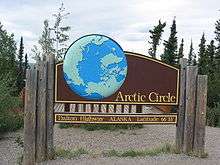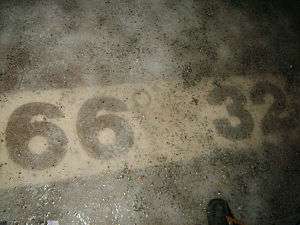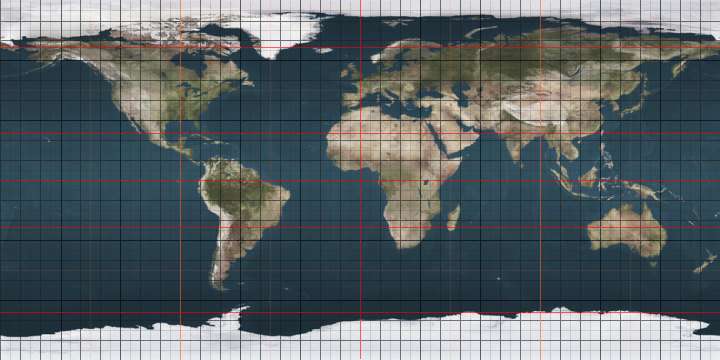Arctic Circle
The Arctic Circle is the most northerly of the five major circles of latitude that mark maps of the Earth. The region north of this circle is known as the Arctic, and the zone just to the south is called the Northern Temperate Zone. North of the Arctic Circle, the sun is above the horizon for twenty-four continuous hours at least once per year (and therefore visible at midnight) and below the horizon for twenty-four continuous hours at least once per year (and therefore not visible at noon); this is also true within the equivalent polar circle in the Southern Hemisphere, the Antarctic Circle.
The position of the Arctic Circle is not fixed; as of 5 December 2016, it runs 66°33′46.5″ north of the Equator.[1] Its latitude depends on the Earth's axial tilt, which fluctuates within a margin of 2° over a 40,000-year period, due to tidal forces resulting from the orbit of the Moon.[2] Consequently, the Arctic Circle is currently drifting northwards at a speed of about 15 m (49 ft) per year.
Etymology
The word "arctic" comes from the Greek word ἀρκτικός (arktikos: "near the Bear, northern")[3] and that from the word ἄρκτος (arktos: "bear").[4] The name refers either to the constellation Ursa Major, the "Great Bear", which is prominent in the northern portion of the celestial sphere, or to the constellation Ursa Minor, the "Little Bear", which contains Polaris, the Pole star, also known as the North Star.[5]
Midnight sun and polar night
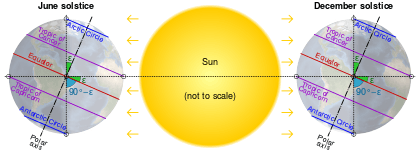
The Arctic Circle is the southernmost latitude in the Northern Hemisphere at which the sun can remain continuously above or below the horizon for twenty-four hours; as a result, at least once each year at any location within the Arctic Circle the sun is visible at local midnight, and at least once it is not visible at local noon.[6]
Directly on the Arctic Circle these events occur, in principle, exactly once per year: at the June and December solstices, respectively. However, because of atmospheric refraction and mirages, and because the sun appears as a disk and not a point, part of the midnight sun may be seen on the night of the northern summer solstice up to about 50 minutes (′) (90 km (56 mi)) south of the Arctic Circle; similarly, on the day of the northern winter solstice, part of the sun may be seen up to about 50′ north of the Arctic Circle. That is true at sea level; those limits increase with elevation above sea level, although in mountainous regions there is often no direct view of the true horizon.
Human habitation
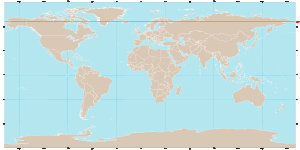
Relatively few people live north of the Arctic Circle due to the severe climate; nonetheless, some areas have been settled for thousands of years by indigenous peoples. Tens of thousands of years ago, waves of people migrated from eastern Siberia across the Bering Strait into North America and gradually eastward to settle. Much later, in the historic period, there has been migration into some Arctic areas by Europeans and other immigrants.
The largest communities north of the Arctic Circle are situated in Russia and Norway: Murmansk (population 307,257), Norilsk (175,365), Tromsø (71,295) and Vorkuta (70,548). Rovaniemi (61,329) in Finland is the largest settlement in the immediate vicinity of the Arctic Circle lying slightly south of the line.
In contrast, the largest North American community north of the Arctic Circle, Sisimiut (Greenland), has approximately 5,000 inhabitants. Of the Canadian and United States Arctic communities, Barrow, Alaska is the largest settlement with about 4,000 inhabitants.
Geography

The Arctic Circle is roughly 17,662 kilometres (10,975 mi) long.[7] (A different source says 16,000 kilometres (9,900 mi).[8]) The area north of the Circle is about 20,000,000 km2 (7,700,000 sq mi) and covers roughly 4% of Earth's surface.[9]
The Arctic Circle passes through the Arctic Ocean, the Scandinavian Peninsula, North Asia, Northern America and Greenland. The land within the Arctic Circle is divided among eight countries: Norway, Sweden, Finland, Russia, the United States (Alaska), Canada, Denmark (Greenland), and Iceland (where it passes through the small offshore island of Grímsey).
Climate
The climate inside the Arctic Circle is generally cold, but the coastal areas of Norway have a generally mild climate as a result of the Gulf Stream, which makes the ports of northern Norway and northwest Russia ice-free all year long. In the interior, summers can be quite warm, while winters are extremely cold. For example, summer temperatures in Norilsk, Russia will sometimes reach as high as 30 °C (86 °F), while the winter temperatures frequently fall below −50 °C (−58 °F).
Sites along the Arctic Circle
Starting at the prime meridian and heading eastwards, the Arctic Circle passes through:
See also
References
- ↑ "Obliquity of the Ecliptic (Eps Mean)". Neoprogrammics.com. Retrieved 2014-05-13.
- ↑ Berger, A.L. (1976). "Obliquity and Precession for the Last 5000000 Years". Astronomy and Astrophysics. 51: 127–135. Bibcode:1976A&A....51..127B.
- ↑ Henry George Liddell and Robert Scott. "Arktikos." A Greek-English Lexicon. Perseus Digital Library.
- ↑ Henry George Liddell and Robert Scott. "Arktos." A Greek-English Lexicon. Perseus Digital Library.
- ↑ "The Great Bear Constellation Ursa Major". Archived from the original on 30 November 2010. Retrieved 10 November 2010.
- ↑ Burn, Chris. The Polar Night (PDF). The Aurora Research Institute. Retrieved 28 September 2015.
- ↑ BBC website, accessed Jan 3, 2016
- ↑ Nuttall, Mark (18 November 2004). Encyclopedia of the Arctic Volumes 1, 2 and 3. Routledge. p. 115. ISBN 978-1579584368. Retrieved 26 July 2016.
- ↑ William M. Marsh; Martin M. Kaufman (2012). Physical Geography: Great Systems and Global Environments. Cambridge University Press. p. 24. ISBN 978-0-521-76428-5.
External links
| Wikimedia Commons has media related to Arctic Circle. |
| Look up arctic circle in Wiktionary, the free dictionary. |
- Terra Incognita: Exploration of the Canadian Arctic—Historical essay about early expeditions to the Canadian Arctic, illustrated with maps, photographs and drawings
- Temporal Epoch Calculations ©2006 by James Q. Jacobs Download: Epoch v2009.xls (modify D4)
- Useful constants" See: Obliquity of the ecliptic
- ArcticFocus Facts and news about Arctic

